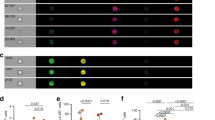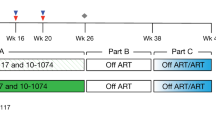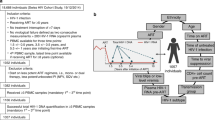Abstract
We examined the pathogenic significance of the latent viral reservoir in the resting CD4+ T cell compartment of HIV-1-infected individuals as well as its involvement in the rebound of plasma viremia after discontinuation of highly active anti-retroviral therapy (HAART). Using heteroduplex mobility and tracking assays, we show that the detectable pool of latently infected, resting CD4+ T cells does not account entirely for the early rebounding plasma HIV in infected individuals in whom HAART has been discontinued. In the majority of patients examined, the rebounding plasma virus was genetically distinct from both the cell-associated HIV RNA and the replication-competent virus within the detectable pool of latently infected, resting CD4+ T cells. These results indicate the existence of other persistent HIV reservoirs that could prompt rapid emergence of plasma viremia after cessation of HAART and underscore the necessity to develop therapies directed toward such populations of infected cells.
This is a preview of subscription content, access via your institution
Access options
Subscribe to this journal
Receive 12 print issues and online access
$209.00 per year
only $17.42 per issue
Buy this article
- Purchase on Springer Link
- Instant access to full article PDF
Prices may be subject to local taxes which are calculated during checkout





Similar content being viewed by others
References
Gulick, R.M. et al. Treatment with indinavir, zidovudine, and lamivudine in adults with human immunodeficiency virus infection and prior anti-retroviral therapy . N. Engl. J. Med. 337, 734– 739 (1997).
Hammer, S.M. et al. A controlled trial of two nucleoside analogues plus indinavir in persons with human immunodeficiency virus infection and CD4 cell counts of 200 per cubic millimeter or less. AIDS Clinical Trials Group 320 Study Team. N. Engl. J. Med. 337, 725– 733 (1997).
Palella, F.J. Jr. et al. Declining morbidity and mortality among patients with advanced human immunodeficiency virus infection. HIV Outpatient Study Investigators. N. Engl. J. Med. 338, 853–860 (1998).
Detels, R. et al. Effectiveness of potent anti-retroviral therapy on time to AIDS and death in men with known HIV infection duration. Multicenter AIDS Cohort Study Investigators. JAMA 280, 1497– 1503 (1998).
Hoyert, D.L., Kochanek, K.D. & Murphy, S.L. Deaths: final data for 1997. Natl. Vital Stat. Rep. 47, 1–104 ( 1999).
Mocroft, A. et al. Changing patterns of mortality across Europe in patients infected with HIV-1. EuroSIDA Study Group. Lancet 352, 1725–1730 (1998).
Dore, G.J., Brown, T., Tarantola, D. & Kaldor, J.M. HIV and AIDS in the Asia-Pacific region: an epidemiological overview. Aids 12 Suppl B, S1–10 ( 1998).
Perelson, A.S. et al. Decay characteristics of HIV-1-infected compartments during combination therapy. Nature 387, 188– 191 (1997).
Natarajan, V. et al. HIV-1 replication in patients with undetectable plasma virus receiving HAART. Lancet 353, 119– 120 (1999).
Furtado, M.R. et al. Persistence of HIV-1 transcription in peripheral-blood mononuclear cells in patients receiving potent anti-retroviral therapy. N. Engl. J. Med. 340, 1614–1622 (1999).
Lewin, S.R. et al. Use of real-time PCR and molecular beacons to detect virus replication in human immunodeficiency virus type 1-infected individuals on prolonged effective antiretroviral therapy. J. Virol. 73, 6099–6103 (1999).
Gunthard, H.F. et al. Evolution of envelope sequences of human immunodeficiency virus type 1 in cellular reservoirs in the setting of potent antiviral therapy . J. Virol. 73, 9404–9412 (1999).
Chun, T.W. et al. Presence of an inducible HIV-1 latent reservoir during highly active antiretroviral therapy. Proc. Natl. Acad. Sci. USA 94, 13193–13197 (1997).
Finzi, D. et al. Identification of a reservoir for HIV-1 in patients on highly active antiretroviral therapy. Science 278, 1295–1300 (1997).
Wong, J.K. et al. Recovery of replication-competent HIV despite prolonged suppression of plasma viremia. Science 278, 1291– 1295 (1997).
Finzi, D. et al. Latent infection of CD4+ T cells provides a mechanism for lifelong persistence of HIV-1, even in patients on effective combination therapy. Nature Med. 5, 512–517 ( 1999).
Zhang, L. et al. Quantifying residual HIV-1 replication in patients receiving combination antiretroviral therapy. N. Engl. J. Med. 340, 1605–1613 (1999).
Chun, T.W. et al. In vivo fate of HIV-1-infected T cells: quantitative analysis of the transition to stable latency. Nature Med. 1, 1284–1290 (1995).
Chun, T.W. et al. Quantification of latent tissue reservoirs and total body viral load in HIV-1 infection. Nature 387, 183–188 (1997).
Chun, T.W. et al. Early establishment of a pool of latently infected, resting CD4+ T cells during primary HIV-1 infection. Proc. Natl. Acad. Sci. USA 95, 8869–8873 ( 1998).
Chun, T.W., Engel, D., Mizell, S.B., Ehler, L.A. & Fauci, A.S. Induction of HIV-1 replication in latently infected CD4+ T cells using a combination of cytokines. J. Exp. Med. 188, 83–91 (1998).
Ho, D.D. Toward HIV eradication or remission: the tasks ahead. Science 280, 1866–1867 (1998).
Schrager, L.K. & D'Souza, M.P. Cellular and anatomical reservoirs of HIV-1 in patients receiving potent antiretroviral combination therapy. JAMA 280, 67– 71 (1998).
Cohen, J. Exploring how to get at—and eradicate—hidden HIV. Science 279, 1854–1855 ( 1998).
Chun, T.W. et al. Effect of interleukin-2 on the pool of latently infected, resting CD4+ T cells in HIV-1-infected patients receiving highly active antiretroviral therapy. Nature Med. 5, 651– 655 (1999).
Chun, T.-W., Davey, R.T., Engel, D., Lane, H.C. & Fauci, A.S. Re-emergence of HIV after stopping therapy. Nature 401, 874–875 ( 1999).
Davey, R.T., Jr. et al. HIV-1 and T cell dynamics after interruption of highly active antiretroviral therapy (HAART) in patients with a history of sustained viral suppression. Proc. Natl. Acad. Sci. U S A 96, 15109–15114 (1999).
Delwart, EL. et al. Genetic relationships determined by a DNA heteroduplex mobility assay: analysis of HIV-1 env genes. Science 262, 1257–1261 (1993).
Delwart, E.L. & Gordon, C J. Tracking changes in HIV-1 envelope quasispecies using DNA heteroduplex analysis. Methods 12, 348–354 (1997).
Delwart, E.C., Herring, A., Rodrigo, A.G. & Mullins, J.I. Genetic subtyping of human immunodeficiency virus using a heteroduplex mobility assay. PCR Methods and Applications. Cold Spring Harbor Laboratory Press, Cold Spring Harbor, N.Y. 4, S202– S216 (1995).
Wolinsky, S.M. et al. Selective transmission of human immunodeficiency virus type-1 variants from mothers to infants. Science 255, 1134–1137 (1992).
Zhu, T. et al. Genotypic and phenotypic characterization of HIV-1 patients with primary infection. Science 261, 1179– 1181 (1993).
Zhang, L.Q. et al. Selection for specific sequences in the external envelope protein of human immunodeficiency virus type 1 upon primary infection. J. Virol. 67, 3345–3356 (1993).
Delwart, E.L., Sheppard, H.W., Walker, B.D., Goudsmit, J. & Mullins, J.I. Human immunodeficiency virus type 1 evolution in vivo tracked by DNA heteroduplex mobility assays. J. Virol.. 68, 6672–6683 (1994).
Wolinsky, S.M. et al. Adaptive evolution of human immunodeficiency virus-type 1 during the natural course of infection. Science 272 , 537–542 (1996).
Lukashov, V.V. & Goudsmit, J. HIV heterogeneity and disease progression in AIDS: a model of continuous virus adaptation. Aids 12 Suppl A, S43–52 (1998).
Cohen, O.J. & Fauci, A.S. HIV/AIDS in 1998-gaining the upper hand? JAMA 280, 87–88 (1998).
Chun, T.W. & Fauci, A.S. Latent reservoirs of HIV: Obstacles to the eradication of virus. Proc. Natl. Acad. Sci. USA 96, 10958–10961 (1999).
Cavert, W. et al. Kinetics of response in lymphoid tissues to antiretroviral therapy of HIV-1 infection. Science 276, 960–964 (1997).
Cavert, W. & Haase, A.T. A national tissue bank to track HIV eradication and immune reconstruction. Science 280, 1865–1866 (1998).
Zhang, H. et al. Human immunodeficiency virus type 1 in the semen of men receiving highly active antiretroviral therapy. N. Engl. J. Med. 339, 1803–1809 (1998).
Ostrowski, M.A. et al. Effect of immune activation on the dynamics of human immunodeficiency virus replication and on the distribution of viral quasispecies. J. Virol. 72, 7772–7784 (1998).
Acknowledgements
The authors thank C. Yoder and J. Metcalf for scheduling patient visits and for providing patient laboratory data. They also thank S. Moir for helpful discussions and review of the manuscript and the National Institute of Allergy and Infectious Disease Study Coordinators and Case Managers as well as their patients for their willingness to participate in these studies.
Author information
Authors and Affiliations
Corresponding author
Rights and permissions
About this article
Cite this article
Chun, TW., Davey, R., Ostrowski, M. et al. Relationship between pre-existing viral reservoirs and the re-emergence of plasma viremia after discontinuation of highly active anti-retroviral therapy . Nat Med 6, 757–761 (2000). https://doi.org/10.1038/77481
Received:
Accepted:
Issue Date:
DOI: https://doi.org/10.1038/77481
This article is cited by
-
Stationary distribution and extinction of a multi-stage HIV model with nonlinear stochastic perturbation
Journal of Applied Mathematics and Computing (2022)
-
Identification of the natural product berberine as an antiviral drug
AMB Express (2020)
-
The Brain Retains: Nonhuman Primate Models for Pediatric HIV-1 in the CNS
Current HIV/AIDS Reports (2020)
-
Modeling the role of macrophages in HIV persistence during antiretroviral therapy
Journal of Mathematical Biology (2020)
-
Transcriptional signature of resting-memory CD4 T cells differentiates spontaneous from treatment-induced HIV control
Journal of Molecular Medicine (2020)



